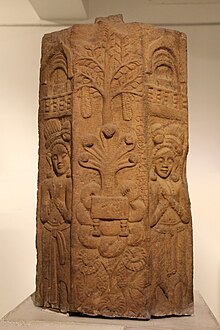Mucilinda


Mucilinda (Sanskrit: मुचिलिन्द; Pali: Mucalinda) is a nāga who protected Śākyamuni Buddha from the elements after his enlightenment.[2]
It is said that six weeks after Gautama Buddha began meditating under the Bodhi Tree, the heavens darkened for seven days, and a prodigious rain descended. However, the mighty King of Serpents, Mucilinda, came from beneath the earth and protected with his hood the One who is the source of all protection. When the great storm had cleared, the serpent king assumed his human form, bowed before the Buddha, and returned in joy to his palace.
Development
[edit]Mucalinda first appears in the Mucalinda Sutta, where it is described that the naga king protected Buddha from the elements by encircling Buddha's body seven times with his coils and standing with his hood spread over. Generally we find statues and carvings of Muchalinda with seven heads, as discovered at the Ta Prohm-temple in Cambodia, in September 2024.[3] After Buddha finished meditating and the sky cleared, Mucalinda adopted the form of a youth and bowed before him.[4]
The first existent artwork depicting Mucalinda comes from a 2nd-century BC stupa in Pauni, Maharashtra, where the naga is portrayed as having five heads and guarding Buddha's empty seat. Contemporaneous artwork from Sanchi has him portrayed in zoo-anthropomorphic form and attended by a retinue of nagini.[4]
Mahayana
[edit]According to the Lalitavistara Sutra, the Buddha found himself in the domain of Mucilinda five weeks after his enlightenment. Mucilinda, along with nāgas from the four cardinal directions, approached him and coiled around his body seven times to shelter him from the inclement weather. They did so for seven days and seven nights. After the storm had let up, the nāgas returns to their respective domains and Mucilinda paid homage to the Buddha, circumambulating him three times before departing.[5]
Artistic representations
[edit]The subject of Buddha meditating under the protection of Mucalinda is very common in Lao Buddhist art. A particularly striking gigantic modern rendition is present in Bunleua Sulilat's sculpture park Sala Keoku.
Art depicting Buddha with Mucalinda's hood over him might have been influenced by Jain art of Parshvanatha, himself depicted as a man with a cobra-like hood.[4]
See also
[edit]References
[edit]- ^ "The bas-relief at Pauni or Bharhut in India, which dates back to about the second century B.C., represents a vacant throne protected by a naga with many heads. It also bears an inscription of the Naga Mucalinda (Fig. 3)" SPAFA Digest: Journal Of SEAMEO Project in Archaeology and Fine Arts (SPAFA). SPAFA Co-ordinating Unit. 1987. p. 4.
- ^ Thanissaro, Bhikkhu. "Muccalinda Sutta: About Muccalinda".
- ^ https://www.miamiherald.com/news/nation-world/world/article292815444.html
- ^ a b c Jason Johns, Jyotsna Rani Nag, Muchalinda Buddha:- An Interdisciplinary approach to Reinterpret the Depiction of the Buddha with Muchalinda Naga, Journal of Archaeological Studies in India, Vol. 1, No. 1, 2021, pp. 140-157
- ^ "The Play in Full". 84000. Retrieved 13 January 2025.
